Recent Labor Market Conditions for Black Workers
The Biden-Harris Administration has been dedicated to ensuring that the post-COVID economic recovery benefits all Americans, particularly Black Americans. A previous CEA blog highlighted strong labor market outcomes for Black Americans from early 2020 through the summer of 2022. This issue brief updates that analysis, looking at outcomes through 2023. Chapter 1 of the 2024 Economic Report of the President noted that the sustained strong labor market during this time led to sizable benefits for middle class workers, and historically strong outcomes for Black Americans. These benefits are evident in several ways, as outlined below.
Looking at unemployment, from September 2022 to February 2024, the Black unemployment rate remained at or below 6 percent for the longest period on record (highlighted in green in Figure 1). Indeed, in April 2023, the unemployment rate for Black workers dropped to 4.8 percent, the lowest since series began. The latest data shows that unemployment rate for Black workers was 5.6 percent in April 2024 continuing the trend of low unemployment rate for this group by historical standards. For context, the average unemployment rate for Black Americans was about 8 percent from 2016 to 2020 and 11 percent from 2000 to 2015.
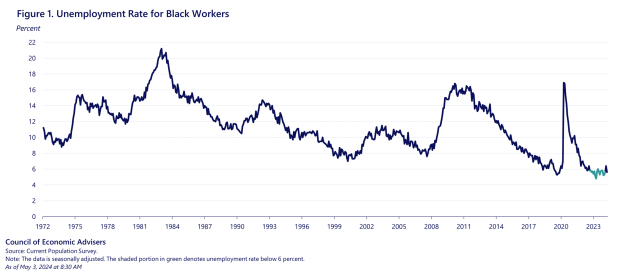
Low unemployment rates can sometimes be attributed to potential workers not seeking jobs. However, the historically low unemployment rates for Black Americans have coincided with strong labor market participation. The 2024 Economic Report of the President, highlighted that the Black-White employment-population ratio gap, after accounting for factors like age, education, marital status, and geographic region, reached historic lows in 2023. By the end of 2023, there was little to no unexplained gap for females, and the gap for males was lower than any year on record (see Figure 2).
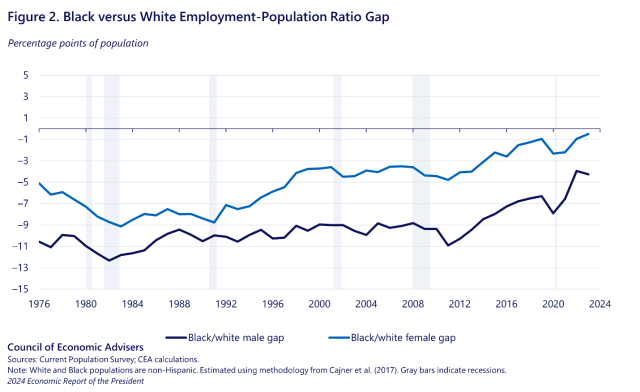
Wage growth is another key metric of labor market success. The CEA’s previous analysis revealed strong nominal wage growth from July 2021 to July 2022, particularly for Black workers. More recent trends show similar strength for Black workers in real wage growth (wage growth beyond inflation, as shown in Figure 3a). The year-over-year change in real median wage growth is currently positive for Black, White, and Hispanic workers (Figure 3b). Since July 2023, the average annual pace of real median wage growth has been 1.4, 1.5, and 1.3 percent for Black, White, and Hispanic workers, respectively (Figures 3a and 3b).
To compare changes from before the pandemic while accounting for seasonality, we compare the second half of 2019 to that of 2023. Between these time periods, real average wages (inflation-adjusted) increased by 9.5 percent ($2.30) for Black workers, compared to a 6.7 percent increase ($2.21) for White workers.[1] We explore the reasons for these larger relative wage gains for Black workers below.
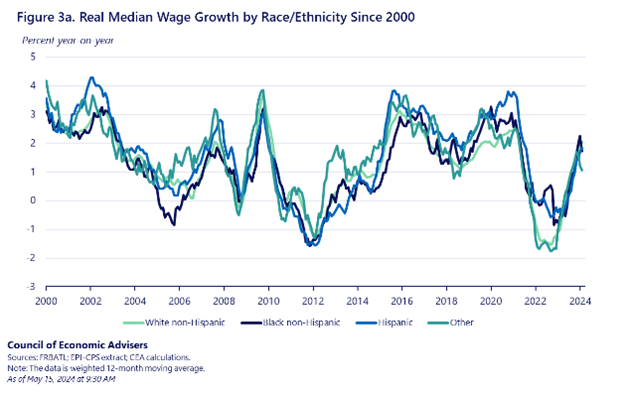
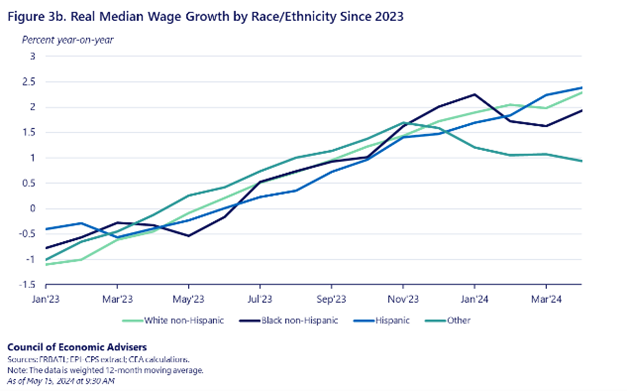
What Led to These Larger Relative Wage Gains for Black Workers?
In principle, the stronger wage gains for Black workers can potentially be attributed to two factors: faster wage growth in industries with a high proportion of Black workers, and/or a higher likelihood of Black workers being employed in high-wage industries post-pandemic (i.e., upskilling or occupational upgrading). We find compelling evidence of the latter.
Figure 4 explores the first factor by plotting the change in real wages by industry (between July-December 2019 and July-December 2023) against the share of Black workers in each industry in the second half of 2019. While some sectors experienced larger real wage growth than others (for instance, the Information sector saw a $8 increase, while Mining saw a $1 gain), there were only small differences in wage gains across sectors that employed larger shares of Black workers in 2019. Notably, Education and Health Services, the sector with the largest share of Black workers in 2019, saw similar real wage gains as sectors with smaller shares of Black workers. Therefore, while Black workers benefited from a general increase in real wages across various sectors, this does not explain their relatively larger wage gains.
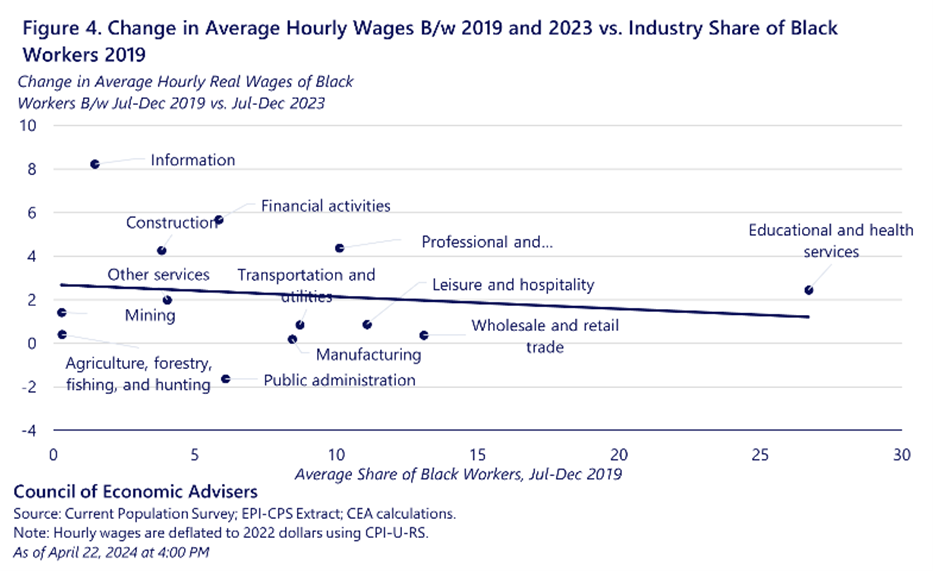
The second explanation could be occupational or sectoral upskilling among Black workers. Previous CEA analysis comparing industry shifts of Black workers between 2019 and 2022 supports this early on in the recovery. Figure 5 updates and builds on this analysis, showing the change in the share of Black workers in each industry from July-December 2019 to July-December 2023, against the average hourly real wages in that industry in the second half of 2019. Black workers were more likely to be employed in higher-wage sectors like Information, Financial Activities, and Professional and Business Services, which also saw high wage growth since 2019. Conversely, the share of Black workers in lower-wage sectors like Leisure and Hospitality and Wholesale Retail Trade decreased.

Figure 6 presents an analysis similar to Figure 5, but focuses on specific occupations. The findings align with the industry-level analysis. Comparing the latter half of 2019 with 2023, the largest increases in the share of Black employment were in generally higher-paying roles such as managers and registered nurses. Moreover, occupations like cashiers and aides in nursing, psychiatric, and home health services, which are generally lower-paying, saw the largest decreases in Black worker representation.

Table 1 quantifies the impact of occupational upgrading by showing what the nominal wages for different racial and ethnic groups would have been in 2023, using the actual changes in occupations but assuming that occupations maintained their 2019 wages. This helps quantify the effect of workers moving to higher-paying occupations. This table shows that Black Americans have maintained their stride of “occupational upgrade” or net advancement to higher-paying jobs on average after the pandemic. Specifically, the average employed Black worker in 2019 was in a job that paid $23.8 an hour, while today, the average Black worker is in a job that would have paid nearly $24.8 an hour in 2019 – a 4.2 percent increase. This is about 2 percentage points higher than the increase for all Americans.

To more formally asses how much of the wage changes over time are due to general wage changes (due to a tight overall labor market) versus upskilling (i.e., moving to higher-wage or high-wage-growth occupations) we used an Oaxaca-Blinder decomposition to analyze average real wage increases for Black and White workers from the latter half of 2019 to that of 2023, accounting for inflation. Consistent with Figure 5, the decomposition attributes about 41 percent (about 1 dollar) of the real wage increase for Black workers to occupational upgrading, with the remainder due to wage increases within occupations and other unobservable factors. For White workers, occupational upgrading accounts for approximately 30 percent (roughly 66 cents)– indicative of overall improvements that are more pronounced for Black workers.
Under the Biden-Harris Administration, economic disparities between Black and White Americans have been reduced. The employment rate of Black Americans has increased, leading to historically small racial employment gaps. The robust labor market, characterized by national unemployment below 4 percent for over two years and faster wage growth for the bottom 80 percent of workers, has benefited the middle and working classes, especially Black Americans. Notably, Black, White, Hispanic and Asian workers have all experienced wage increases that are faster than inflation (Figure 3b). The robust wage gains for Black workers are partly due to their occupational upskilling and increased employment in high-wage sectors. Relative to before the pandemic, Black Americans have made progress in several other key economics areas as well. Black business ownership grew at its fastest pace between 2019 and 2022 in the past three decades. The rate of homeownership has also increased for Black Americans in recent years. Despite remaining disparities, these developments are encouraging.
[1] The data for wages comes from Economic Policy Institute’s (EPI) hourly wage series based on the Current Population Survey. This measures the hourly wage for non – self employed workers paid hourly or non-hourly. It includes imputed values for respondents with top-coded weekly earnings or weekly hours but does not include overtime, tips, commissions for hourly workers.
